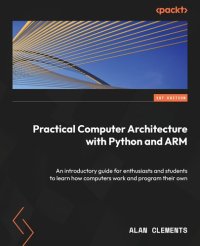
Ebook: Practical Computer Architecture with Python and ARM
Author: Alan Clements
- Genre: Computers // Programming: Compilers
- Year: 2023
- Publisher: Packt Publishing
- Edition: 1
- Language: English
- epub
Learn computer architecture with Python and ARM, simulating assembly program execution and designing a computer simulator Purchase of the print or Kindle book includes a free PDF eBook
Key Features
Build a computer simulator with Python: Learn computer architecture by designing and constructing a simulator
Python for architecture: Use Python to simulate and execute assembly language instructions
ARM programming on Raspberry Pi: Explore ARM assembly language and run programs on Raspberry Pi
Book Description
This comprehensive guide offers a unique and immersive learning experience by combining Python programming with ARM architecture.
Starting with an introduction to computer architecture and the flow of data within a computer system, you’ll progress to building your own interpreter using Python. You’ll see how this foundation enables the simulation of computer operations and learn ways to enhance a simulator by adding new instructions and displaying improved results.
As you advance, you’ll explore the TC1 Assembler and Simulator Program to gain insights into instruction analysis and explore practical examples of simulators. This will help you build essential skills in understanding complex computer instructions, strengthening your grasp of computer architecture. Moreover, you’ll be introduced to the Raspberry Pi operating system, preparing you to delve into the detailed language of the ARM computer. This includes exploring the ARM instruction set architecture, data-processing instructions, subroutines, and the stack.
With clear explanations, practical examples, and coding exercises, this resource will enable you to design and construct your own computer simulator, simulate assembly language programs, and leverage the Raspberry Pi for ARM programming.
What you will learn
Master the core principles of computer architecture
Understand the role of registers, memory, and data flow in computers
Discover how to design and implement a computer simulator using Python
Simulate and execute assembly language programs on the simulator
Enhance the simulator using new instructions for improved output
Analyze complex computer instructions for deeper architectural understanding
Explore the ARM instruction set and data processing on the Raspberry Pi
Develop proficiency in writing, assembling, and running ARM code on the Raspberry Pi
Who this book is for
This book is for university students studying computer science, particularly those enrolled in a computer architecture module. With its practical approach and succinct explanations, it is also suitable for hobbyists, enthusiasts, and self-learners seeking a deeper understanding of computer systems. The book assumes foundational knowledge of number bases, binary arithmetic, and Boolean logic concepts. While it primarily caters to the computer science field, this book is less geared toward electrical or electronics engineering.
Key Features
Build a computer simulator with Python: Learn computer architecture by designing and constructing a simulator
Python for architecture: Use Python to simulate and execute assembly language instructions
ARM programming on Raspberry Pi: Explore ARM assembly language and run programs on Raspberry Pi
Book Description
This comprehensive guide offers a unique and immersive learning experience by combining Python programming with ARM architecture.
Starting with an introduction to computer architecture and the flow of data within a computer system, you’ll progress to building your own interpreter using Python. You’ll see how this foundation enables the simulation of computer operations and learn ways to enhance a simulator by adding new instructions and displaying improved results.
As you advance, you’ll explore the TC1 Assembler and Simulator Program to gain insights into instruction analysis and explore practical examples of simulators. This will help you build essential skills in understanding complex computer instructions, strengthening your grasp of computer architecture. Moreover, you’ll be introduced to the Raspberry Pi operating system, preparing you to delve into the detailed language of the ARM computer. This includes exploring the ARM instruction set architecture, data-processing instructions, subroutines, and the stack.
With clear explanations, practical examples, and coding exercises, this resource will enable you to design and construct your own computer simulator, simulate assembly language programs, and leverage the Raspberry Pi for ARM programming.
What you will learn
Master the core principles of computer architecture
Understand the role of registers, memory, and data flow in computers
Discover how to design and implement a computer simulator using Python
Simulate and execute assembly language programs on the simulator
Enhance the simulator using new instructions for improved output
Analyze complex computer instructions for deeper architectural understanding
Explore the ARM instruction set and data processing on the Raspberry Pi
Develop proficiency in writing, assembling, and running ARM code on the Raspberry Pi
Who this book is for
This book is for university students studying computer science, particularly those enrolled in a computer architecture module. With its practical approach and succinct explanations, it is also suitable for hobbyists, enthusiasts, and self-learners seeking a deeper understanding of computer systems. The book assumes foundational knowledge of number bases, binary arithmetic, and Boolean logic concepts. While it primarily caters to the computer science field, this book is less geared toward electrical or electronics engineering.
Download the book Practical Computer Architecture with Python and ARM for free or read online
Continue reading on any device:

Last viewed books
Related books
{related-news}
Comments (0)